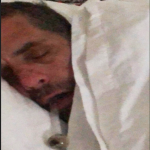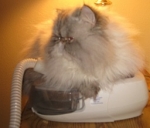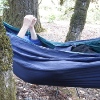OMG - Just retruned from Sleep Doc, a replacement for CPAP ?
OMG - Just retruned from Sleep Doc, a replacement for CPAP ?
First and fore mostly, I want to assure everyone this is not a commercial !! I've been on CPAP therapy for 5 years now, and at age 40 get a little frustrated knowing that I will need to lose like 100 lbs (sure right away on that one ) or I may spend the next 40 or so years of my life attached to a hose every night (sorry, just my jaded view of CPAP, but I too cannot live without it - just being stubborn I guess)
Anyway, after asking my Sleep Doctor about any emerging technologies & sharing him what a pain it is to travel with my CPAP, he advised me that there is SOMETHING NEW ! Ok, it's not a fool-proof replacement (yet) for CPAP - But I tried it & they really seem to work. It's only available by prescription & the concept is pretty simple. The product is called ProVent, and they are like band aids with vents in the middle.
Check it out! http://www.proventtherapy.com/
Again, there is no sales pitch here, I just thought I would share something that maybe replacement someday to CPAP, especially when traveling. Hopefully someday technology will rid us of Sleep Apnea, but this to me was "cool" enough to share with the entire forum.
I'd love to know if anyone else has heard of this & if you have used it did it work? My Doc says he has several people who have converted & use almost exclusively.
Look forward to everyone's input.
Anyway, after asking my Sleep Doctor about any emerging technologies & sharing him what a pain it is to travel with my CPAP, he advised me that there is SOMETHING NEW ! Ok, it's not a fool-proof replacement (yet) for CPAP - But I tried it & they really seem to work. It's only available by prescription & the concept is pretty simple. The product is called ProVent, and they are like band aids with vents in the middle.
Check it out! http://www.proventtherapy.com/
Again, there is no sales pitch here, I just thought I would share something that maybe replacement someday to CPAP, especially when traveling. Hopefully someday technology will rid us of Sleep Apnea, but this to me was "cool" enough to share with the entire forum.
I'd love to know if anyone else has heard of this & if you have used it did it work? My Doc says he has several people who have converted & use almost exclusively.
Look forward to everyone's input.
- remstarcpap
- Posts: 312
- Joined: Mon Feb 16, 2009 2:17 pm
Re: OMG - Just retruned from Sleep Doc, a replacement for CPAP ?
Interesting. But looking at one of the studies quoted, AHI was reduced to about 10! Most of us here would not be very happy at a level of 10. Also, at $150 per month, or $5 per night, not such a cost efficient way to treat apnia. Although I bet one could reuse the device many nights, esp if you taped it on.
Maybe the manufacturer wants to have us test it.
Maybe the manufacturer wants to have us test it.
_________________
| Mask: AirFit™ P10 Nasal Pillow CPAP Mask with Headgear |
| Humidifier: S9™ Series H5i™ Heated Humidifier with Climate Control |
| Additional Comments: Tape on mouth |
Re: OMG - Just retruned from Sleep Doc, a replacement for CPAP ?
Seems like this would only work if you never open your mouth when sleeping... otherwise there goes the pressure. At least with cpap when you open your mouth, you're still getting some pressure from the air coming in, but with this, it seems like you'd lose all pressure.
_________________
| Mask: Mirage Activa™ LT Nasal CPAP Mask with Headgear |
| Humidifier: S9™ Series H5i™ Heated Humidifier with Climate Control |
| Additional Comments: ResScan 3.12, APAP 9 - 13, no EPR, ClimateControl 75F |
(yet another Jeff)
- DreamStalker
- Posts: 7509
- Joined: Mon Aug 07, 2006 9:58 am
- Location: Nowhere & Everywhere At Once
Re: OMG - Just retruned from Sleep Doc, a replacement for CPAP ?
It probably only work for people with low pressure needs and I would be afraid of CO2 buildup.
My CPAP works great and has become a normal part of my life.
My CPAP works great and has become a normal part of my life.
President-pretender, J. Biden, said "the DNC has built the largest voter fraud organization in US history". Too bad they didn’t build the smartest voter fraud organization and got caught.
Re: OMG - Just retruned from Sleep Doc, a replacement for CPAP ?
It completely does not address the issue of airway narrowing - it assumes your whole problem is in your nose. How silly.
_________________
| Mask: Ultra Mirage™ Full Face CPAP Mask with Headgear |
| Humidifier: IntelliPAP Integrated Heated Humidifier |
- JohnBFisher
- Posts: 3821
- Joined: Wed Oct 14, 2009 6:33 am
Re: OMG - Just retruned from Sleep Doc, a replacement for CPAP ?
And it's a great solution if you have central apnea or ComplexSAS or ... It *MIGHT* work if you have mild OSA. But then weight loss might also work. But based on the complaints of my family when I was a teen (and at ideal weight) this would never have been enough for me.
Hmmm.. Some math here: $5 per night * 365 nights per year * 5 years (per xPAP unit it replaces) = $ 9,125 ... YIKES! And I thought my ASV unit was expensive!
But I guess if it helps someone and they don't mind spending $5 per night, why not?
Hmmm.. Some math here: $5 per night * 365 nights per year * 5 years (per xPAP unit it replaces) = $ 9,125 ... YIKES! And I thought my ASV unit was expensive!
But I guess if it helps someone and they don't mind spending $5 per night, why not?
_________________
| Mask: Quattro™ FX Full Face CPAP Mask with Headgear |
| Additional Comments: User of xPAP therapy for over 20 yrs. Resmed & Respironics ASV units with EEP=9cm-14cm H2O; PSmin=4cm H2O; PSmax=15cm H2O; Max=25cm H2O |
"I get up. I walk. I fall down. Meanwhile, I keep dancing” from Rabbi Hillel
"I wish to paint in such a manner as if I were photographing dreams." from Zdzisław Beksiński
"I wish to paint in such a manner as if I were photographing dreams." from Zdzisław Beksiński
- BleepingBeauty
- Posts: 2454
- Joined: Thu Apr 02, 2009 5:30 pm
- Location: Aridzona ;-)
Re: OMG - Just retruned from Sleep Doc, a replacement for CPAP ?
FYI, there's been some discussion here about Provent: search.php?st=0&sk=t&sd=d&keywords=%2Bp ... +&start=15
Veni, vidi, Velcro. I came, I saw, I stuck around.
Dx 11/07: AHI 107, central apnea, Cheyne Stokes respiration, moderate-severe O2 desats. (Simple OSA would be too easy. )
)
PR S1 ASV 950, DreamWear mask, F&P 150 humidifier, O2 @ 2L.
Dx 11/07: AHI 107, central apnea, Cheyne Stokes respiration, moderate-severe O2 desats. (Simple OSA would be too easy.
PR S1 ASV 950, DreamWear mask, F&P 150 humidifier, O2 @ 2L.
Re: OMG - Just retruned from Sleep Doc, a replacement for CPAP ?
Interesting, but I'm kind of picky, I don't want anything up my nose, or taped to my nose. And the cost factor, YIKES!!! I'll stick with my ff mask, and my machine.
_________________
| Mask | ||||
 | ||||
| Additional Comments: She wasn't what you would call refined, She wasn't what you would call unrefined, She was the kind of a person who keeps a Parrot. *Mark Twain* | ||||
Judy R.
Re: OMG - Just retruned from Sleep Doc, a replacement for CPAP ?
I question if the "treatment" is a nasal obstruction itself because it reduces nasal access to airflow when in place. Reminds me of the little adhesive strips to place over nose to hold nares open for treatment.
elg5cats
elg5cats
_________________
| Machine | Mask | |||
 | ||||
| Additional Comments: , Mirage Micro Nasal, ResMed Airsence 10 for her with heated humifier | ||||
Only competition with a Bed of Kats for improved sleep is an xPAP approved by the Kats. In Memory: KoKo Macademia KitKat 10-20-1989--May 30. 2007....Kats are purrfect role models for sleep hygiene along with 2 snuggly Tibetan Spaniels.
-
split_city
- Posts: 466
- Joined: Mon Apr 23, 2007 2:46 am
- Location: Adelaide, Australia
Re: OMG - Just retruned from Sleep Doc, a replacement for CPAP ?
Yeah this has been discussed a bit before. It's an interesting concept but doubt it would work too well with a large % of OSA patients.
Here's an abstract from a study:
Not necessarily. You have to consider the physiology of this device and think outside the square. Introducing resistance during expiration potentially limits the amount of air expired. Consequently, lung volume is perhaps increased as the patient breathes in more than what they expire. As mentioned before, a higher lung volume reduces airway collapsibility and AHI:Julie wrote:It completely does not address the issue of airway narrowing - it assumes your whole problem is in your nose. How silly.
Sleep. 2003 Nov 1;26(7):851-6.
The influence of lung volume on pharyngeal mechanics, collapsibility, and genioglossus muscle activation during sleep.
Stanchina ML, Malhotra A, Fogel RB, Trinder J, Edwards JK, Schory K, White DP.
Pulmonary/Critical Care Division, Brigham and Women's Hospital, Harvard Medical School, Boston, Mass, USA. mstanchina@lifespan.org
STUDY OBJECTIVES: Previous studies in both awake and sleeping humans have demonstrated that lung-volume changes substantially affect upper-airway size and pharyngeal resistance and, thus, may influence pharyngeal patency. We sought to systematically investigate the isolated effects of lung-volume changes on pharyngeal collapsibility and mechanics and genioglossus muscle activation during stable non-rapid eye movement sleep. We hypothesized that lower lung volumes would lead to increased pharyngeal collapsibility, airflow resistance, and, in compensation, augmented genioglossus muscle activation. DESIGN: Nineteen normal individuals (age, 30.4 +/- 0.5 years; body mass index: 24.5 +/- 0.4 kg/m2) were studied during stable non-rapid eye movement sleep in a rigid head-out shell equipped with a variable positive/negative pressure attachment for manipulations of extrathoracic pressure and, thus, lung volume. SETTING: Sleep physiology laboratory. PARTICIPANTS: Normal healthy volunteers. INTERVENTIONS: N/A. MEASUREMENTS AND RESULTS: We measured change in end-expiratory lung volume (EELV) (magnetometers), genioglossus electromyogram (GGEMG) (intramuscular electrodes), pharyngeal pressure, and collapsibility of the pharynx in response to a brief pulse of negative pressure (-8 to -15 cm H2O) under the following conditions: (1) baseline, (2) increased EELV (+1 liter), and (3) decreased EELV (-0.6 liter). Reduced lung volumes led to increased inspiratory airflow resistance (7.54 +/- 2.80 cm H2O x L(-1) x s(-1) vs 4.53 +/- 1.05 cm H2O x L(-1) x s(-1), mean +/- SEM, P = 0.02) and increased genioglossus muscle activation (GGEMG peak 14.6% +/- 1.5% of maximum vs 8.6% +/- 1.5% of maximum, maximum P = 0.001) compared to baseline. The pharynx was also more collapsible at low lung volumes (4.3 +/- 0.5 cm H2O vs 5.4 +/- 0.6 cm H2O, P = 0.04). CONCLUSIONS: We conclude that upper-airway muscles respond to changes in lung volumes but not adequately to prevent increased collapsibility. These results suggest that lung volume has an important influence on pharyngeal patency during non-rapid eye movement sleep in normal individuals.
It would be interesting to know how much lung volume is increased with this device. I doubt very much, compared to the effects of CPAP anyway. The device is only likely to help OSA patients with mild OSA.Thorax. 2006 May;61(5):435-9. Epub 2006 Feb 20.
Effect of increased lung volume on sleep disordered breathing in patients with sleep apnoea.
Heinzer RC, Stanchina ML, Malhotra A, Jordan AS, Patel SR, Lo YL, Wellman A, Schory K, Dover L, White DP.
Sleep Medicine Division, Brigham and Women's Hospital, Harvard Medical School, Boston, MA, USA. rheinzer@post.harvard.edu
BACKGROUND: Previous studies have shown that changes in lung volume influence upper airway size and resistance, particularly in patients with obstructive sleep apnoea (OSA), and that continuous positive airway pressure (CPAP) requirements decrease when the lung volume is increased. We sought to determine the effect of a constant lung volume increase on sleep disordered breathing during non-REM sleep. METHODS: Twelve subjects with OSA were studied during non-REM sleep in a rigid head-out shell equipped with a positive/negative pressure attachment for manipulation of extrathoracic pressure. The increase in lung volume due to CPAP (at a therapeutic level) was determined with four magnetometer coils placed on the chest wall and abdomen. CPAP was then stopped and the subjects were studied for 1 hour in three conditions (in random order): (1) no treatment (baseline); (2) at "CPAP lung volume", with the increased lung volume being reproduced by negative extrathoracic pressure alone (lung volume 1, LV1); and (3) 500 ml above the CPAP lung volume(lung volume 2, LV2). RESULTS: The mean (SE) apnoea/hypopnoea index (AHI) for baseline, LV1, and LV2, respectively, was 62.3 (10.2), 37.2 (5.0), and 31.2 (6.7) events per hour (p = 0.009); the 3% oxygen desaturation index was 43.0 (10.1), 16.1 (5.4), and 12.3 (5.3) events per hour (p = 0.002); and the mean oxygen saturation was 95.4 (0.3)%, 96.0 (0.2)%, 96.3 (0.3)%, respectively (p = 0.001). CONCLUSION: An increase in lung volume causes a substantial decrease in sleep disordered breathing in patients with OSA during non-REM sleep.
Here's an abstract from a study:
So AHI decreased from ~25 to ~14. Pffftt, not even worth it!SCIENTIFIC INVESTIGATIONS
A Multicenter, Prospective Study of a Novel Nasal EPAP Device in the Treatment of Obstructive Sleep Apnea: Efficacy and 30-Day Adherence
Leon Rosenthal, M.D.1; Clifford A. Massie, Ph.D.2; Diana C. Dolan, B.S.1,3; Bryan Loomas, B.S.5; Jerrold Kram, M.D.4; Robert W. Hart, M.D.2
1Sleep Medicine Associates of Texas, Dallas, TX; 2Chicago Sleep Group, Elk Grove Village, IL;3University of North Texas, Denton, TX; 4California Center for Sleep Disorders, Alameda, CA; 5Ventus Medical, Inc., Belmont, CA
Study Objectives: Evaluate the efficacy of a novel device placed in the nares that imposes an expiratory resistance for the treatment of obstructive sleep apnea (OSA) and evaluate adherence to the device over a 30-day in-home trial period.
Design: One diagnostic and 3 treatment polysomnograms were administered in a Latin-square design to identify the optimal expiratory resistance to be used during the 30-day in-home trial. Subjects had repeat polysomnography with the prescribed device at the end of the 30-day trial.
Setting: Multicenter study.
Participants: Participants (N = 34; age 27 to 67) with a baseline apnea-hypopnea index (AHI) ≥ 5.
Measurements and Results: The AHI was reduced from 24.5 ± 23.6 (mean ± SD) to an average of 13.5 ± 18.7 (p < 0.001) across initial treatment nights. The AHI was 15.5 ± 18.9 (p = 0.001) for the prescribed device at the end of the 30-day trial. Of 24 subjects with an AHI > 10 at baseline, 13 achieved an AHI ≤ 10 on the initial treatment nights; 10 had a similar response on the final treatment night. Percent of the night snoring decreased from 27.5 ± 23.2 to 11.6 ± 13.7 (p < 0.001) on initial treatment nights and 14.6 ± 20.6 (p = 0.013) at the end of the trial; Epworth Sleepiness scores decreased from 8.7 ± 4.0 at baseline to 6.9 ± 4.4 (p < 0.001) at the end of the trial; the Pittsburgh Sleep Quality Index improved from 7.4 ± 3.3 to 6.5 ± 3.6 (p = 0.042). Mean oxygen saturation increased from 94.8 ± 2.0 to 95.2 ± 1.9 (p = 0.023) on initial treatment nights and 95.3 ± 1.9 (p = 0.003) at the end of the trial. Sleep architecture was not affected. Participants reported using the device all night long for 94% of nights during the in-home trial.
Conclusions: Treatment with this novel device was well tolerated and accepted by the participants. An overall reduction in AHI was documented; however, therapeutic response was variable among the participants. Further research is required to identify the ideal candidates for this new therapeutic option in the management of OSA.
-
Guest
Re: OMG - Just retruned from Sleep Doc, a replacement for CPAP ?
The device only works during exhalation. It has no way to impact apneas or hypoapneas during inhalation. I think it's better than nothing, but not as good as a CPAP, if the option is available.
-
split_city
- Posts: 466
- Joined: Mon Apr 23, 2007 2:46 am
- Location: Adelaide, Australia
Re: OMG - Just retruned from Sleep Doc, a replacement for CPAP ?
IMO, I think the bold part of your statement is also important. The airway tends to narrow during inspiration and expiration. For example, this figure is from Morrell et al 1998:Guest wrote:The device only works during exhalation.

It clearly shows the airway getting smaller at end-expiration leading into an apnea. While this group showed that the airway collapsed at a subatmospheric pressure, Badr et al 1995 showed that the airway can passively collapse such as the case during a mixed apnea i.e.negaive airway pressure isn't required to collapse the airway:

Again it comes back to my last message. IF this device sufficiently raised lung volume, it would also help prevent inspiratory collapse. But I agree, CPAP is a much better option because it raises lung volume + splints the airway open with positive pressure. Heinzer et al showed that while raising lung volume did reduce AHI, it didn't eliminate OSA.Guest wrote:It has no way to impact apneas or hypoapneas during inhalation. I think it's better than nothing, but not as good as a CPAP, if the option is available.
- Scarlet834
- Posts: 310
- Joined: Sun Sep 06, 2009 12:24 pm
- Location: California
Re: OMG - Just retruned from Sleep Doc, a replacement for CPAP ?
I can't believe this eliminates obstruction in the lower airway, but I am mindful of Dr. Park's focus on the sinuses and a clear nasal airway for good sleep quality. Perhaps this little item does help some peoples' pathologies.
_________________
| Mask: Swift™ LT For Her Nasal Pillow CPAP Mask with Headgear |
| Additional Comments: Encore Pro 2.2 |















